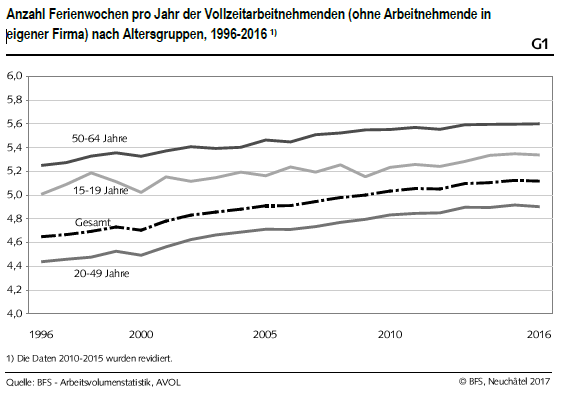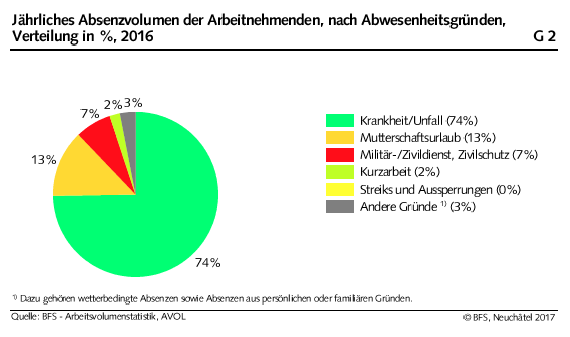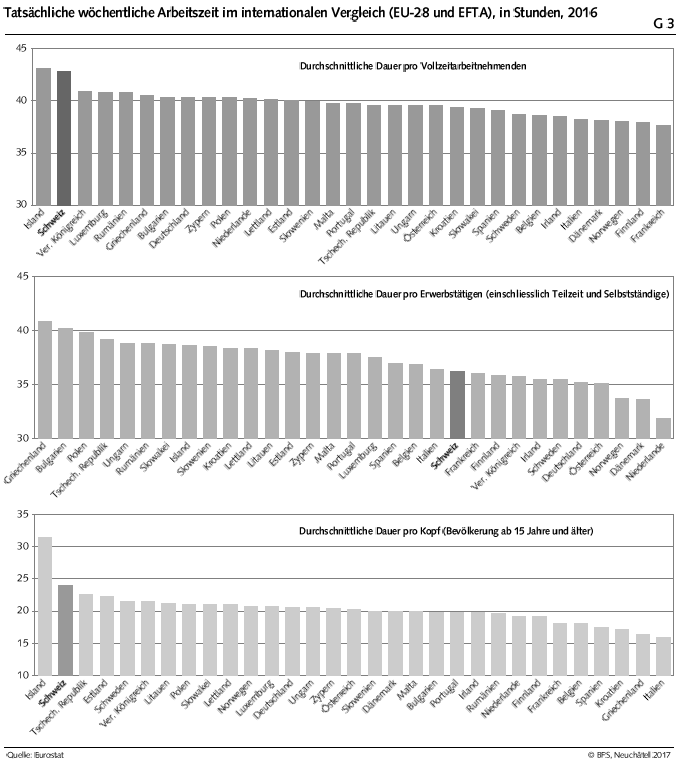Neuchâtel, 27.07.2017 (FSO) – The total number of hours worked in Switzerland reached 7.892 billion in 2016, representing an increase of 1.4% compared with the previous year. According to the Federal Statistical Office (FSO), between 2011 and 2016, the actual weekly hours worked by full-time employees declined by 13 minutes and stood at 41 hours and 10 minutes, whereas the number of weeks of annual holiday continued its gradual increase to 5.12 weeks. Download press release: Swiss Labour Force Survey and its derivative statistics: working hours Translated from German: According to the Labor Statistics (AVOL), the number of hours worked by all Swiss employ- ees in 2016 rose by 1.4 percent to 7.892 billion compared
Topics:
Swiss Statistics considers the following as important: Featured, newslettersent, Swiss Macro, Switzerland Working Hours
This could be interesting, too:
Nachrichten Ticker - www.finanzen.ch writes Krypto-Ausblick 2025: Stehen Bitcoin, Ethereum & Co. vor einem Boom oder Einbruch?
Connor O'Keeffe writes The Establishment’s “Principles” Are Fake
Per Bylund writes Bitcoiners’ Guide to Austrian Economics
Ron Paul writes What Are We Doing in Syria?
Neuchâtel, 27.07.2017 (FSO) – The total number of hours worked in Switzerland reached 7.892 billion in 2016, representing an increase of 1.4% compared with the previous year. According to the Federal Statistical Office (FSO), between 2011 and 2016, the actual weekly hours worked by full-time employees declined by 13 minutes and stood at 41 hours and 10 minutes, whereas the number of weeks of annual holiday continued its gradual increase to 5.12 weeks.
Download press release: Swiss Labour Force Survey and its derivative statistics: working hours
Translated from German:
|
According to the Labor Statistics (AVOL), the number of hours worked by all Swiss employ- ees in 2016 rose by 1.4 percent to 7.892 billion compared to the previous year. Both the number of employees (+ 1.7%) and the number of working days (+ 0.2%, a leap year in 2016) contributed to this increase. This would have been even more pronounced if the actual weekly working time per job had not decreased during the same period (-0.5%). Reduction in the actual working time of full-time employees within five yearsBetween 2011 and 2016, the actual weekly working hours of full-time employees (excluding those working in their own company) decreased by 13 minutes to 41 hours and 10 minutes. In the number of holiday weeks, a constant increase was observed from 5.05 to 5.12 weeks (+0.3 days). Workers between the ages of 20 and 49 have 4,90 weeks less than 15 to 19 year olds and 50 to 64 year olds (5.34 and 5.60 weeks respectively). |
Number of holiday weeks per year of full-time employees (excluding employees in own company) by age group, 1996-2016 |
Over 44 hours per week in the primary sectorThe highest actual working time per week was registered by the full-time workers of the primary sector (2016: 44 hours and 40 minutes). This is followed by the economic sections “business” (42 hours and 7 minutes), “credit and insurance” (42 hours and 1 minute) and “professional, scientific and technical services” (41 hours and 52 minutes). More absences than overtimeIn the case of full-time employees, fewer overtime hours (rate 2016: 2.3%) were recorded as absences (rate 2016: 4.0%). The only exceptions are the economic sections “Credit and insurance industries” and “Professional, scientific and technical services”. The absentee rate (3.3% and 2.5%) was lower than the overtime rate (4.0% and 3.1%) for these two economic segments.
|
Annual Absence Volume of Workers, Based on Absences, Distribution in% 2016 |
Rate of health-related absencesHealth-related absences (illness or accident) were responsible for the largest proportion (74%) of the annual absenteeism of the workers, followed by absences due to maternity leave (13%) and military or community service (7%). In 2016, the rate of health-related absences for full-time workers was 3.0 per cent. The lowest rate (1.7%) was attributable to the “Other Services” section of the economy, the highest (4.5%) to “construction”. International comparisonIn 2016, the actual weekly working time of full-time employees in the EU28 was 39 hours and 36 minutes. On a country-by-country comparison, Switzerland recorded the highest real working time per week for full-time employees (42 hours and 48 minutes), followed by the United Kingdom (40 hours and 54 minutes) and Romania and Luxembourg (40 hours and 48 minutes each). At the end of the ranking were France (37 hours and 36 minutes) and Finland (37 hours and 54 minutes). Looking at the population as a whole, Switzerland (with 36 hours and 12 minutes) was among the countries with the lowest actual working time per week in 2016. The reason for this is the high share of part-time employees. In Greece, the actual weekly working hours were the highest (40 hours and 54 minutes), and the Netherlands (31 hours and 48 minutes) on the other end of the ranking. The average in the EU28 was 36 hours and 36 minutes. If the total volume of hours worked is proportionate to the total population (15 years and over), Switzerland is at the top of the EU28 with 23 hours and 58 minutes. This is due to the high employment rate in Switzerland. Italy (15 hours and 55 minutes) and Greece (16 hours and 19 minutes) were the last, while the average in the EU28 was 19 hours and 20 minutes. |
Actual weekly working hours in international comparison, in hours, 2016 |
German text: Schweizerische Arbeitskräfteerhebung und abgeleitete Statistiken: Arbeitszeit
Tags: Featured,newslettersent,Switzerland Working Hours



